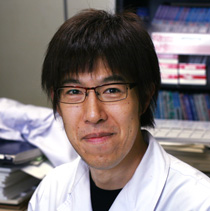
 > Research
> Yoshihiko Hirohashi[CANCER STEM CELL]
> Research
> Yoshihiko Hirohashi[CANCER STEM CELL]
Associate Professor
Yoshihiko Hirohashi, M.D. Ph.D.
PROFESSIONAL EDUCATION
Wakayama Medical University, Sapporo, Japan, M.D., 1996
Wakayama Medical University, Sapporo, Japan, Ph.D., 2002
POSTDOCTORAL EXPERIENCE
Oxford University, Oxford, UK (Dr. Mark I Greene Laboratory), 2002-2003
University of Pennsylvania, Philadelphia (Dr. Mark I Greene Laboratory), 2003-2004
SELECTED PUBLICATIONS
Immune responses to human cancer stem-like cells/cancer-initiating cells. Hirohashi Y, Torigoe T, Tsukahara T, Kanaseki T, Kochin V, Sato N. Cancer Sci..2016 Jan;107(1):12-7. doi: 10.1111/cas.12830. (PubMed)
HSP DNAJB8 controls tumor-initiating ability in renal cancer stem-like cells. Nishizawa S, Hirohashi Y, Torigoe T, Takahashi A, Tamura Y, Mori T, Kanaseki T, Kamiguchi K, Asanuma H, Morita R, Sokolovskaya A, Matsuzaki J, Yamada R, Fujii R, Kampinga HH, Kondo T, Hasegawa T, Hara I, Sato N. Cancer Res..2012 Jun 1;72(11):2844-54. doi: 10.1158/0008-5472.CAN-11-3062.(PubMed)
Olfactory Receptor Family 7 Subfamily C Member 1 Is a Novel Marker of Colon Cancer-Initiating Cells and Is a Potent Target of Immunotherapy. Morita R,Hirohashi Y, Torigoe T, Ito-Inoda S, Takahashi A, Mariya T, Asanuma H, Tamura Y, Tsukahara T, Kanaseki T, Kubo T, Kutomi G, Mizuguchi T, Terui T, Ishitani K, Hashino S, Kondo T, Minagawa N, Takahashi N, Taketomi A, Todo S, Asaka M, Sato N. Clin Cancer Res..2016 Jul 1;22(13):3298-309. doi: 10.1158/1078-0432.CCR-15-1709. (PubMed)

Since acquired immune system recognize antigens, immunization of cancer patients using tumor-associated antigens (TAAs) will bring augmentation of anti-tumor immunity. On this point of view, we and other groups have been trying to identify TAAs. These efforts have brought us identifications of novel TAAs including, Survivin, Livin, HIFPH3, CEP55, AMACR and DNAJB8. And, collabolation with clinical departments, we have already launched cancer peptide vaccine therapy using Survivin derived antigenic peptide.。
Cancer stem-like cell (CSC)/cancer-initiating cell (CIC) research are booming, recently. CSCs/CICs are defined as small population of cancer cells which have (1) higher tumor-initiating ability, (2) self renew ability and (3) differentiation ability (Figure 1). Furthermore, CSCs/CICs are known to be resistant to standard cancer therapies including chemotherapy and radiotherapy. Therefore, CSCs/CICs are thought to be a major mechanisms of cancer recurrence after treatment and distant metastasis (Figure 2).
To analyze the molecular mechanisms of CSCs/CICs, we tried to isolate CSCs/CICs from several types of cancer cells, and we succeeded to isolate CSCs/CICs as side population (SP) cells and Aldefluor-positive cells (Figure 3). For example, SP cells derived from lung carcinoma cell line showed 100-fold higher tumor-initiating ability compared with main population (MP) (=non-SP) cells. cDNA microarray and RT-PCR analysis revealed that SOX2 and Oct3/4 which are known to be expressed in embryonal stem (ES) cells, are also preferentially expressed in CSCs/CICs. And, SOX2 is related to tumor-initiating ability by gene transfer and gene specific knock down using siRNAs. Therefore, CSCs/CICs share genetically similar pathway with ES cells and this similality might be related to higher tumor-initiating ability of CSCs/CICs.。
CSCs/CICs have higher tumor-initiating ability and also treatment resistance. Thus, targeting CSCs/CICs should be key factor to achieve cancer eradication and cure. We are now analyzing CSCs/CICs as targets of cancer immunotherapy, and found that CTLs can recognize colon CSCs/CICs efficiently (Ref. 2). And, TAAs which can be targets of CTLs can be classified into three groups according to the expression in CSCs/CICs and non-CSCs/CICs (Figure 4, Ref. 5). They are; (1) CSC antigens: preferentially expressed in CSCs/CICs, (2) shared antigens: expressed in both CSCs/CICs and non-CSCs/CICs and (3) non-CSC antigens: preferentially expressed in non-CSCs/CICs. Then, we may ask which antigen is the best as a target of cancer immunotherapy.
We identified novel CSC antigen, DNAJB8 which is expressed in CSCs/CICs preferentially, and compared the potency with one of shared antigens, Survivin. Surprisingly, DNA vaccination into mice revealed that immuization with DNAJB8 brought grater anti-tumor effect than that of Survivin (Figure 5, Ref. 1). These findings indicate that (1) CSC antigens are more potent as targets of cancer immunotherapy to achieve anti-tumor effect. We are now, designing CSC targeting immunotherapy using CSC antigens, and are welcome to share our excitements. Please join us!